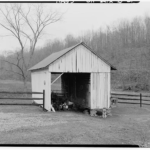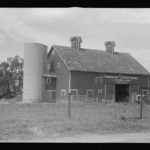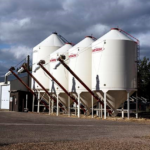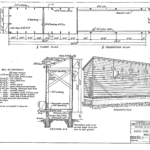By Gabe Ross, Farm Manager

Have you ever heard of a corn crib, silo or grain bin? One of them sounds like a place for baby corn to sleep, but it’s not. These terms are often confused or used interchangeably but are actually very different buildings.
Corn cribs are buildings that store ear corn. Ear corn is dry corn that is picked from the plant by hand or with a corn picker in the fall and stored right on the cob. These ears of corn are later shelled, which is a term that means to remove the kernels. This corn is used for livestock feed. Corn cribs were often wood but sometimes metal with holes punched in it or wire on the sides. The wood slats or holes allowed air to flow through the corn so it would dry and wouldn’t rot. Wood cribs were usually rectangular and metal cribs were typically round. In the 1930s most farms stored corn in this fashion and would have had some sort of corn crib.
Today some farmers still use ear corn and cribs, but with the advent of the combine most corn cribs got repurposed or disappeared. The combine combines the picking and the shelling of the corn into one machine, hence the name. Corn that is harvested by a combine must be stored in grain bins, which are solid metal, or sometimes wood, bins with no air holes or gaps in the sides that shelled corn would run out of. Wheat, oats, and soybeans are also stored this way. Today, grain bins are usually round corrugated structures that sort of look like some of the old round corn cribs but have no holes in the sides.

Silos are used to store silage, which is whole corn stalks that have been harvested partially green and blown into tall tubes that keep the air out and allow the corn, leaves, stems, ears and all to go through a fermentation process, kind of like making Saur kraut. This is also used as feed for livestock, often dairy cattle. Silage can be made from many other forage crops as well. Silos can be wood, brick, concrete or metal. Many farms in the 1930s had wooden, concrete or brick silos, but today they are often metal and very tall.
Here at Gallant Farm we are building a wooden corn crib over the next few months using 1938 Department of Agriculture plans. This will give us a place to store our ear corn and get it out of the barn. Come out to the farm this winter and see the construction process in person. Don’t hesitate to ask us questions and as we will be happy to share more information about the use of corn cribs on farms.








